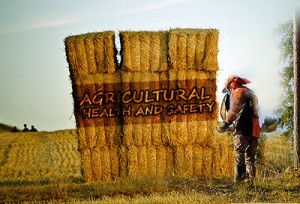 The agricultural sector is one of the UK’s most dangerous. Fatal accident rates in the industry are higher than those in any of the UK’s other sectors, beating even the notoriously dangerous construction industry. Between 2010 and 2011, Health and Safety Executive figures showed 42 fatalities caused by an accident at work in the agricultural sector were reported, which is consistent with the industry’s average rates over the previous five years.
The agricultural sector is one of the UK’s most dangerous. Fatal accident rates in the industry are higher than those in any of the UK’s other sectors, beating even the notoriously dangerous construction industry. Between 2010 and 2011, Health and Safety Executive figures showed 42 fatalities caused by an accident at work in the agricultural sector were reported, which is consistent with the industry’s average rates over the previous five years.
Despite the fact that under 1.5% of the UK’s employed population work in agriculture, a hugely disproportionate number of fatal accidents at work occur in the sector – in a typical year, between 15% and 20% of all the UK’s fatal workplace accidents are in agriculture. Back injuries compensation claims are also more common – the self-reported illness rate of the industry is usually higher than the UK’s average. Major injuries are particularly common – while the UK’s industry average was 101.5 serious injuries per 100,000 workers in 2010 to 2011, this figure was more than double that for agricultural workers, reaching 242.1.
As a result, there are many health and safety regulations that protect workers and self-employed people in the sector. Employers should adhere to these rules and guidelines carefully to ensure they do not have to face the fallout of a workplace fatality or a back injury compensation claim.
What are Common Workplace Personal Injuries in the Agricultural Sector?
Some of the most common workplace injuries experienced by workers in the agricultural sector include:
– Zoonotic Infections
Zoonotic infections are diseases that are transmitted from animals to humans. These include potentially fatal diseases, such as variant CJD (Mad Cow Disease), anthrax or rabies, as well as less lethal conditions such as bird flu, cowpox or cat scratch disease. Common zoonotic infections seen in the UK include cryptosporidiosis, e-coli and salmonella.
– Musculoskeletal Disorders
Musculoskeletal disorders are those that affect joints, muscles, ligaments, nerves and tendons – essentially, any part of a body’s musckoloskeletal system. Back injury compensation cases are common in the agricultural sector as workers are often engaged in manual handling, repetitive motions or other jobs that put their backs under strain.
– Hand-arm Vibration, Whole-body Vibration and Vibration White Finger
These vibration-related illnesses are caused by power tools. Some of the symptoms of these illnesses include pain, stiffness and paralysis of the joints.
– Respiratory Illnesses
Organic dust exposure is a particularly prevalent problem in the agricultural sector and this has been linked to upper respiratory tract infections.
Why do Accidents at Work happen in the Agricultural Sector?
Although agricultural sector workers can use dangerous machinery and have particularly strenuous tasks, many back injuries compensation claims can be traced back to common dangers that are seen in all workplaces. Slips, trips and falls are a concern in the agricultural sector – muddy floors, frostiness, slipperiness or messiness can lead to catastrophe when combined with heavy machinery or manual handling. Trailing cables, pallets, sacks and discarded tools can also obstruct working areas.
Falls from height are also a risk that features prominently in agriculture. Catwalks can be placed above feed lofts and grain bins, while forestry and related industries may require extensive periods of working at height. While back injuries compensation claims can occur when people fall from height, fatal accidents are also common, although some people are lucky to escape from such falls relatively unharmed.
Poor standards of maintenance may also be an issue. Banisters or ladders can corrode, or older buildings can fall apart. Machinery might not be kept up to standard, and power tools could malfunction or break. There is a culture of resourcefulness in agriculture and a make-do-and-mend or just-get-on-with-it attitude could see workers accepting hazardous working conditions and put businesses at risk of compensation claim for back injury.
However, the risks that health and safety regulations deal with are too numerous to mention. Livestock, for instance, can be unpredictable. People may be called to work in the early morning or last thing at night, or may have to work outdoors in cold weather or in the midst of a heatwave. Many agricultural businesses are ran by families and have no health and safety policies or any leadership on risk management. Training standards may be low or non-existent and employers may have a distrust of government bodies and ‘red tape’.
Unfortunately, these factors can lead people to suffer serious workplace accidents – fatal accident compensation claims are regularly seen in agriculture, alongside back injuries claims. Businesses should do all they can to protect the safety of their workforce – while employers may feel that it ‘wading through red tape’ is not worth it, they could actually save the lives of a member of staff.

